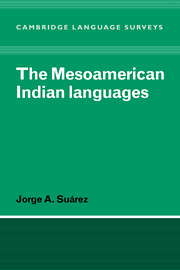Book contents
- Frontmatter
- Contents
- List of illustrations
- List of tables
- Preface
- Notational conventions
- Map 1 Present-day distribution of Mesoamerican Indian languages
- Table 1 Classification of Mesoamerican Indian languages and index to map 1
- 1 The study of Mesoamerican Indian languages
- 2 Dialects, languages and linguistic families
- 3 Phonology I
- 4 Phonology II
- 5 Morphology I
- 6 Morphology II
- 7 Syntax I
- 8 Syntax II
- 9 Preconquest literary traditions
- 10 The prehistory of Mesoamerican Indian languages
- 11 Indian languages after the conquest
- Appendix: Sources for sentences quoted in chapters 7 and 8
- References
- Language index
- Subject index
11 - Indian languages after the conquest
Published online by Cambridge University Press: 05 November 2009
- Frontmatter
- Contents
- List of illustrations
- List of tables
- Preface
- Notational conventions
- Map 1 Present-day distribution of Mesoamerican Indian languages
- Table 1 Classification of Mesoamerican Indian languages and index to map 1
- 1 The study of Mesoamerican Indian languages
- 2 Dialects, languages and linguistic families
- 3 Phonology I
- 4 Phonology II
- 5 Morphology I
- 6 Morphology II
- 7 Syntax I
- 8 Syntax II
- 9 Preconquest literary traditions
- 10 The prehistory of Mesoamerican Indian languages
- 11 Indian languages after the conquest
- Appendix: Sources for sentences quoted in chapters 7 and 8
- References
- Language index
- Subject index
Summary
Language policies
As stated in chapter 2, an indeterminable number of Indian languages became extinct as a consequence of the conquest. Looking at a map of language distribution at the time of first contact it can be seen that except for northern languages located beyond Mesoamerica proper, most of those which disappeared were spoken by groups occupying small areas in regions of great linguistic diversity, chiefly along the coast and nearby inland fringes in the present-day Mexican States of Guerrero, Michoacan and Colima. For the most part, languages became extinct rather early during the sixteenth century chiefly because of the sharp decline in population caused by epidemics. In some cases whole groups were probably wiped out; in others a decimated group may have shifted linguistically to Spanish or to other Indian languages.
Replacement of a given language by Nahuatl certainly occurred, although it has not been clearly demonstrated in how many cases the shift actually took place. Nahuatl groups which the Spaniards brought along with them, either by force or as allies, settled in regions where different languages were spoken, and the favouring of Nahuatl by Spaniards may have been conducive to language replacement.
- Type
- Chapter
- Information
- The Mesoamerican Indian Languages , pp. 163 - 174Publisher: Cambridge University PressPrint publication year: 1983

